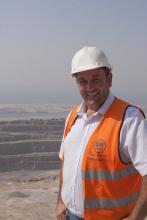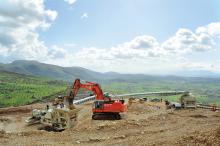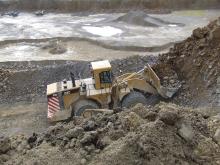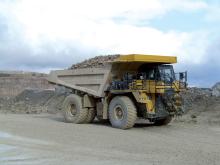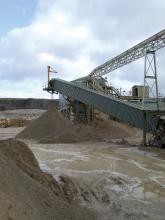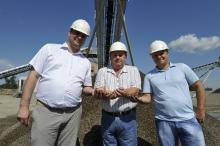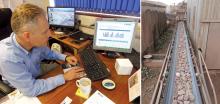
For his second look at major quarries in the UK, Patrick Smith visits a ‘flagship quarry’ with history on its doorstep
Steeped in history, the Priory Church of Saint Mary and Saint Hardulph has a dramatic setting. The church, which has a history dating back over 1,300 years, is perched on top of a hill, its sides having been dug away over many years through quarrying. Not any more.
True, it stands proudly at the top of
But being a nationally important building, with a Grade I listing (the highest for historic buildings) for its exceptional architectural interest, nothing can be done that would endanger it.
Indeed, the church contains the largest collection (and some of the finest examples) of Anglo-Saxon sculptures while its Golden Amber gravel footpath, providing a durable surface for church visitors, comes from the nearby quarry.
Stone has been quarried here for at least a century, probably longer, and permission has been given to expand both quarries.
Breedon Quarry in the village of Breedon-on-the-Hill (on the border of Counties Leicestershire and Derbyshire) is the headquarters of Breedon Aggregates, the UK’s largest independent aggregates company, and it also produces the company’s highly-prized decorative stone.
A kiometre away is the Breedon group’s flagship 70 hectare Cloud Hill Quarry where, as at Breedon, the rocks of the Lower Carboniferous series comprise a thick succession of partially dolomitised, well-bedded limestones.
But the way this rock is gained, processed and despatched has changed dramatically in the past few years with a central control room, run by a staff of six, capable of running many of the processes remotely. Such is the automation that Cloud Hill employs only 26 staff, a number from the locality, while just two people run the smaller, specialty stone operation.
It is here that the famous Breedon Golden Amber gravel, said to be the ultimate self-binding solution for perfect pathways and driveways and the only self-binding gravel to hold The Royal Warrant, is processed.
A 100% environmentally friendly product, the natural limestone material graded 12mm to fines with a high content of naturally occurring marl, gives it the self-binding properties.
In this quarry, which has been given permission to quarry a further 16 million tonnes, a mobile
“We have to be very careful with the Golden Amber as well as the Wayfarer material we produce here,” says quarry manager Neil Gamble.
“It is a very slow process. The unit we use is capable of 300tonnes/hour but we only feed it 100tonnes/hour. In this quarry we produce all our decorative materials.”
The special material from the quarry has been specified for use at many buildings including Chatsworth House, which attracts an estimated 650,000 visitors a year; The National War Memorial Arboretum and Sandringham Estate, The Queen’s private estate.
“Indeed, from a geological viewpoint the whole quarry site is a Site of
“We waste nothing at the quarry. Water, which is a problem at Cloud Hill, is collected in tanks and then pumped up to tanks at the top. It is allowed to settle and clean water is used in our asphalt and concrete processes while the ‘sludge’ that is taken off can also be sold.”
Breedon Aggregates notes that in the 1930s, quarrying at Breedon was carried out by manual labour: initially with men using picks and shovels who hewed the stone from the rock face. Tubs were then filled manually by a quarry worker and a young lad with his pony would pull the tub along the rails to the stone crushers (known as crackers). There it was crushed, screened and fed into hoppers according to size.
“This was very strenuous work for both the tub filler and the pony pulling the heavy load and the men filling the tubs were paid as piece workers. There were some 20 ponies or so and a similar number working at Cloud Hill and the ponies were stabled at Breedon next to the quarry.
“The two lime kilns at Breedon used to keep many local people employed for many years as the stone quarried from Breedon and Cloud Hill is a chemical form of calcium carbonate, rich in Magnesium. When heated to high temperatures it produced lime, a valuable building material to mix with cement for building purposes and has a huge benefit to soils and grassland, hence widely used by farmers and gardeners.
“The quarry looks very different these days.”
A few years ago the Cloud Hill Quarry underwent a major upgrade costing millions of pounds, and this included new crushing and screening facilities; new asphalt and concrete plants and a new method of weighing and ticketing products and their destinations.
“The concept here was to have an office with everybody upstairs from where the whole quarry was controlled including distribution from the weighbridge. The conveyor system now in use and the scalpings plant are controlled from this office,” says Carl Ashurst, head of Breedon Aggregates East Region.
At Cloud Hill there are two out-bridges and one in-bridge for weighing and the systems were developed by Avery Weigh-Tronix in conjunction with Breedon Aggregates.
In 2000, Ennstone, an acquisitive Midlands (region)-based aggregates group, acquired Breedon, which owned the Breedon Hill and Cloud Hill quarries, and the Ennstone businesses were acquired by Breedon Holdings in March 2009.
In August, 2010, Breedon Holdings, which then owned the building materials companies Ennstone Thistle and Ennstone Johnston, was acquired by
In January 2012, Breedon Aggregates acquired
As the flagship of Breedon Aggregates quarrying operations, Cloud Hill produces some 1.2 million tonnes of material each year with the 32mm being is most popular.
Until a few years ago a fleet of 50tonne dump trucks (ADTs) hauled rock from the bottom of the 100m deep quarry, some 2km from the rock face to the processing plant.
The rock is won by drilling and blasting about once a week when it is planned that around 30,000tonnes of material will be displaced, says quarry manager Neil Gamble.
Originally this was taken by the trucks to the processing plant where a series of static crushers and screens produced a relatively limited range of products.
Today the rock is loaded at the face by a Caterpillar 990 Series 2 wheeled loader into the primary crusher, a mobile Metso LT140 jaw crusher at the bottom of the quarry.
It incorporates the big C140 jaw crusher with a large nominal feed opening and a 2.1m long fixed jaw. The resulting material is placed onto one of a series of tracked-wheeled mobile conveyors linking the primary crusher, wherever it is working, to the bottom end of a 1.2m wide ground conveyor which runs some 800m up the one-in-eight main access ramp to the next stage. The fixed conveyor replaces the ADTs.
“When the quarry was upgraded we bought six
The link conveyors each measure over 40m in length and have a carrying capacity of around 800tonnes/hour.
Telestack International, based in Northern Ireland, designed the conveyors in partnership with Breedon. Each unit has its own switchgear and electrical connections, and this allows them to operate independently or linked with the others.
“This main production gives us better quality rock for chippings and making asphalt and concrete,” says Carl Ashurst. “At the top of the quarry we have a Steelfields Major 60 concrete plant that can produce up to 60m³/hour and a
“We also do granite and high polished stone value (psv) materials with the granite from our quarry at Leaton [County Shopshire, England] and the psv we buy in.”
In another part of the quarry where there is poorer grade rock a mobile Kleemann 172 impactor is fed by a
The quarry also operates a Caterpillar 365 excavator that dresses the quarry faces; the asphalt and concrete plants are fed by a
A new Volvo L220G wheeled loader loads Type 1 material going up the access ramp and a Komatsu WA480 wheeled loader is used at the wash plant.
In the quarry floor Ashurst explains the future plans.
“We have been given permission to develop the southern end of the quarry and this will mean removing a total of over 1 million m³ of overburden. First we will have to continue the bund around the quarry and plant it so that the quarry is screened off.
“The plan is to continue quarrying at the northern end of the quarry and to go a further two benches down. This will then be backfilled with the overburden although I don’t think we will do this for another three to four years.”
Some remaining 4.8 million tonnes of stone is expected to be removed from the northern part of the quarry.
CRUSHING
1 x Metso LT140 jaw crusher
1 x Metso NP1520 impact crusher
1 x Sandvik 4800 cone crusher
1 x Kleemann impact crusher
EXCAVATORS
1 x Caterpillar 365
WHEELED LOADER
1 x Caterpillar 966
1 x Caterpillar 990 Series 2
1 x Komatsu WA600
1 x Komatsu WA480
1 x Volvo L180
1 x Volvo L220G
ARTICULATED DUMP TRUCKS
1 x Caterpillar 740
2 x Volvo A35 trucks
Leicestershire County Council, which gave the extension permission, noted that following a carefully phased development, extraction could eventually take place down to 68m, allowing the extraction of a further 9.255 million tonnes of limestone.
Once quarrying ceases, the site will be restored to provide woodland, scrub and species rich grassland.
At present in the quarry after primary crushing of the material by the LT140, material transported via the ground conveyor system discharges at the top of the access ramp onto the tail end of the primary surge pile delivery conveyor, and this passes through a short tunnel beneath an access road before rising to its discharge height of 25m.
At the covered scalpings plant material is taken from -40mm down and is then taken for washing after passing over a screen from Austrian company Binder.
From a recovery tunnel larger material from the quarry is fed into a Metso NP1520 impact crusher for secondary crushing. The unit can process 500tonnes/hour and after this it passes over a series of screens where 6mm, 10mm, 14mm, 32mm size material is screened out. This is either loaded directly on to delivery vehicles via load-out bays beneath the site’s overhead storage hoppers or are stockpiled.
Oversize material goes back over the conveyor and through a hydraulically-adjusted
“That screen goes over another set of screens and from that we make dust 10-14mm, which is kept in two big sheds to keep it dry. This means less fuel is used at the asphalt plant,” says Gamble.
At the nearby wash plant scalpings are fed into a hopper where they are mixed with water and forced up a pipeline where the material is washed prior to going over a series of screens to produced washed 6mm, 10mm and 14mm products. Minus 3mm down material from the process is removed and left with the clear washed dust to be used as a sand replacement in concrete.
“All our materials are quality tested in state-of-the-art laboratories and can be tailored to specific requirements,” says Ashurst.
Speedy work
Materials from Cloud Hill are processed and blended to produce bespoke surfaces for speedway racing tracks.
“Every track has its own specific material requirements and by blending a mixture of crushed limestone and clay we are able to create a bespoke material to suit each customers’ exact needs,” says the company.
The extensive range of limestone quarried at the quarry means Breedon can also control the colour of its shale to offer spectacular visual effect.
“This means that whether the track is solely used for speedway bikes or whether it also carries stock cars, we can change the material to suit the proposed traffic and even we can change material according to weather forecasts.”
Working with the former speedway world champion, Ole Olsen and his son Torben, Breedon has also developed a semi-permanent track shale which is successfully used at the Speedway Grand Prix circuits in Cardiff (Wales), Gothenburg (Sweden) and Copenhagen (Denmark).
The shale can be rolled with water ready for racing, then removed from the venue and stored until it is required again for the next meeting.

